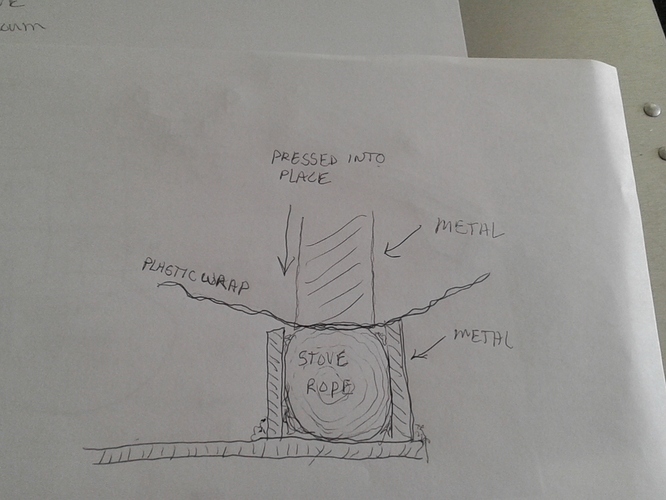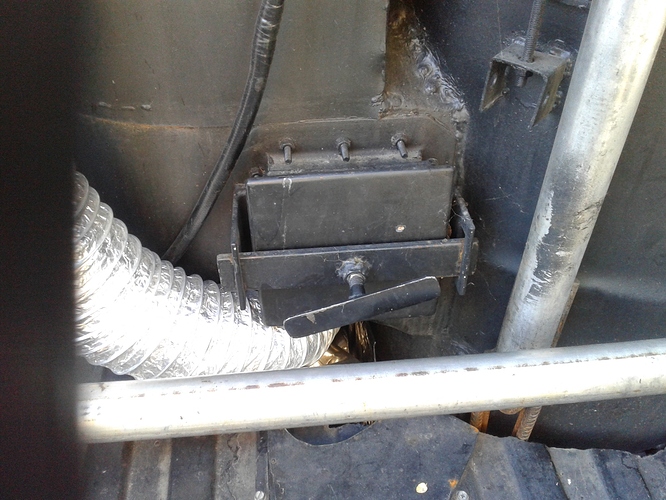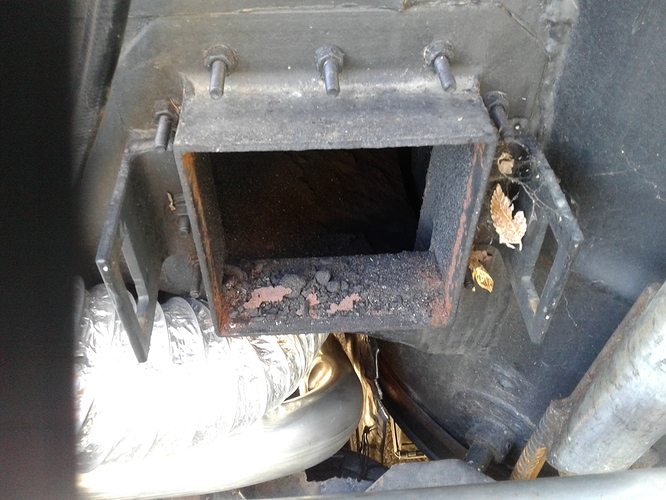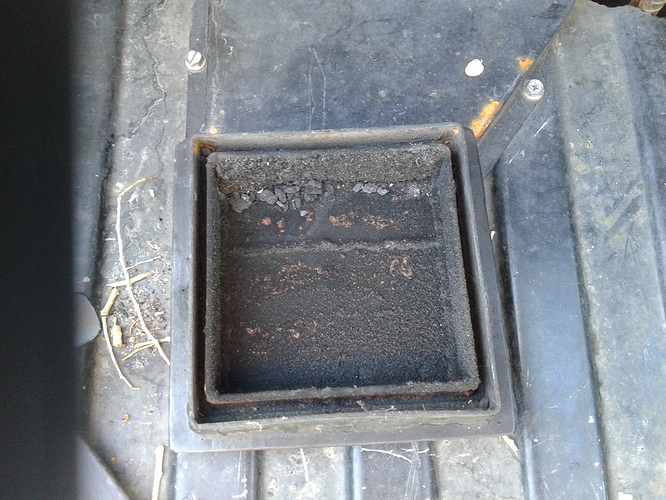Then I understand, you are just right, I dared not run the gas backwards.
Hi JO, I have had no problems with the stove rope (if) you impregnate it with the Red or Black high heat silicone. I cut it to the length I want, and place in a plastic seal lock storage food bag. Squeeze some silcone into the bag remove the air seal it, and work the Silcone into the stove rope thoroughly. The slot or grove that the rope is place in to has 3 sides that is deep. It is cleaned to the metal.
Remove the end of the rope from the bag through a small hole this will remove some of the excess silicone on the rope, hang it up by one end to let it get tacky. Place the rope into your round or square slot you made. I put a little silicone into the slot and let it get tacky before putting the rope into the slot. I place plastic food wrap over the rope and clamp it into place. This will squish the stove rope down into the slot and it fills the voids forming a good sealing gasket.
Let it dry for 2 days before removing the pressure on the gasket, then let it dry 2 more days with the plastic wrap removed. You can put some grease on the seal and use it. It is the best seal I have ever made. No leaks even with positive pressure in the gasifier.
It would be difficult to get this seal out. My hopper seal that still is working will be replaced with this kind of seal when the new hopper needs to be built. With out a good sealing air tight gasifier you with have problems getting it to run making good gas.
Bob
Thanks for the tip, should try to do something like that to the lid.
I used the black stove rope adhesive to glue the rope to the hopper and after it dried, I greased the top mating surface so it seals good and releases good.
I have used this process and it worked for a while, but then the rope an silicone get packed harder and harder until it is a hard surface against a hard surface. That doesn’ t work, then. TomC
There was a German ww2 song regarding gasifier maintinence. One part l remember says something like “keep the seals well lubricated with graphite grease”. I like doing that on all RTV seals. Even the seals that get wery hot bennefit from this practise. Grease melts away but it prevents stuff sticking to the seal.
Thanks Bob, that’s pretty much what I used with the Rabbit’s hopper lid seal. Worked good, but my experience is the silicone turned to jelly after a couple months of every day use and had to be replaced over and over again. This is why I went the rubber seal route with the Mazda. It worked very well for 18 months, but the flimsy copper lid has taken enough beating and I couldn’t find a rubber seal replacement.
I did the same.
I didn’t do that.
Obviously I’m not familiar to @KristijanL’s song 
I’ll add some grease before tomorrow’s lightup.
Kristijan,
Do you think you can locate the song you mentioned. I would be interested in seeing a translation of it. A Google search only turned up this wood-gas song:
Sorry, l dont remember where l saw that. It was a old youtube video someone posted here. Will try to find it.
You who drive with newer cars and pickups, (1994-2010) do you know if the gas affects the catalyst, probes etc. negatively?
I don’t think I’ve ever read anyone having cat or O2-sensor problems due to woodgas. However computers may object in newer vehicles than 95 (not all of them). Also, I haven’t come across many vehicles newer than 95 with the possibility of manual timing advance . Most have crank sensors.
Codes aren’t checked at inspection here until 2002 models. That’s when obd2 became mandatory in the EU. Safest bet would be to at least settle with a 2001.
Oh, and metall intake of course.
I did. Me  l used to start the gasifier with motorbreakin at WOT down the 1 mile hill to the main road. Then once l reved in neutral and it spit the whole cat comb trugh the tailpipe
l used to start the gasifier with motorbreakin at WOT down the 1 mile hill to the main road. Then once l reved in neutral and it spit the whole cat comb trugh the tailpipe  looks like pumping unburnt fuel trugh the motor caused the cat to overheat.
looks like pumping unburnt fuel trugh the motor caused the cat to overheat.
But, the real question is why bother? I had the car inspected twice with no cat, emisions were unchanged.
Oh, my Chevy was a 2006. It had computer problems at start but once l figured it out it worked on woodgas flawlessly. I neaded to figure out what l can disconect and what l may not.
Regarding timing, thats a lotery. Some engines run real crappy without timing advance, but my Chevy and Mercedes both seem to run good without any advance.
True North American OBDII is specified to have an active Catalyst Converter Performance Monitor testing cycle. Have before catalyst O2 sensor and after catalytic converter sensors. Compares the sensor readings. Forcing over-rich and over lean cycles to monitor responses.
These WILL detect removed hollow-shell converter core. Or degraded, inactive cores.
Set codes and in inspected areas here scream RAPE! Park-it. Junk-it. Or replace the converter for one that will satisfy the on-board monitoring system.
One of the purposes of specified OBDII was to eliminate actual out of the tail pipe testing. And underhood inspecting.
Have the vehicle self-test active and be the tattle-teller.
“Enhanced” OBDII can be remotely radio pinged and broadcast out a state of condition.
S.U.
Thanks for the answers, I asked for my inspection guy answered like this, when I asked which car I could put gas on.
"It’s not so much a question of which car you get
convert to gas, you may do so in any car.
The idea was to avoid the requirement for a regulated three-way catalyst,
which goes into effect 1989 model for passenger cars and
1993 for petrol-powered light trucks.
I do not think that the exhaust gas purification (lambda probes,
engine control, catalytic converter, ev. air pump, etc.) feel special
good of gas (Contains probably some tar, acids and soot even after
the purification step) and whether these components are broken should
the exhaust gas values become unsuccessful in connection with the inspection."
Ok, @Kristijan blew his cat, but I haven’t heard anyone else mention cat or lambda (O2 sensor) problems due to woodgas. Which probably makes the chance of destroying them as likely as if running gasoline.
Yes, they can be a problem PRIOR to combustion.
In the exhaust? - I doubt it.
Maybe you read about Mr Wayne’s test results at Auburn university. All sorts of probes were attached during extensive testing. He was told he would easily pass California emission requirements (strictest in the US).
I’ve mentioned before, I think woodgas has a bad reputation simply because avarage people were forced to use it during the war, and accidents did happen. If they didn’t know gasoline was flamable and poisonous, that would have caused accidents too.
I’m often asked about those hazards. With limited rhetorical skills I usually stick to one statement and one question:
- Gasoline is poisonous liquid - don’t drink it. Woodgas is poisonous gas - don’t breath it.
- Which do you consider the most likely fire hazard, 50L of gasoline or 50L of woodchunks?
What JO sayd. It is posible to burn the cat even with a badly tuned petrol engine. If all works well there is nothing to wory about.
I am quite sure woodgas emisions are lower thain petrol. There are practicly no hydrocarbons, sulur, and since woodgas likes to run lean, there is probably not much if any CO. Lower burn temperature allso means less NOx.
Ha, l present the exact same thod when l get asked about safety 
Sean French burned out a cat on woodgas. Wayne has never run them to my knowledge.
Carbon dust / soot in the exhaust will collect and melt the cat shut. Yes most of that should burn up in the combustion chamber but nothing is 100%. I would want very good filtration before considering running a cat. Fortunately I live in a non-inspected area.
Hm, with only a hayfilter for 22,000 miles I guess I’ve been lucky then. As far as I know there’s nothing wrong with either of the vehicle’s cats. I even fed them rags and throttle plates 
@Jan Fortunately, with the years and models possible to legally register over here, the only emission requirement is CO. The cat doesn’t need to work. It can be empty, but you’re not allowed to remove it. Any equipment to do with emissions has to stay put, whether they work or not.
JO, I asked for a car from 1998, and got the answer that I can put gas in any car, only the exhaust values work even after driving on gas.
So regardless of the annual model.
Jan, I sent you a private message.
What car was the 98?




